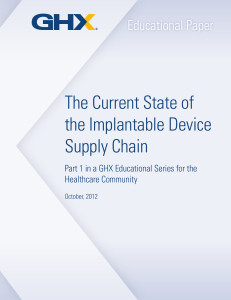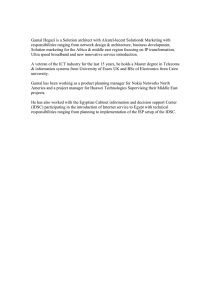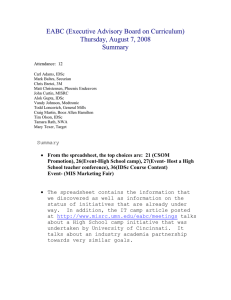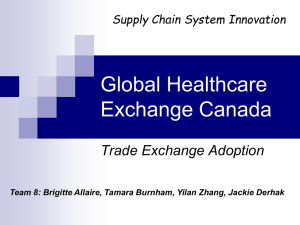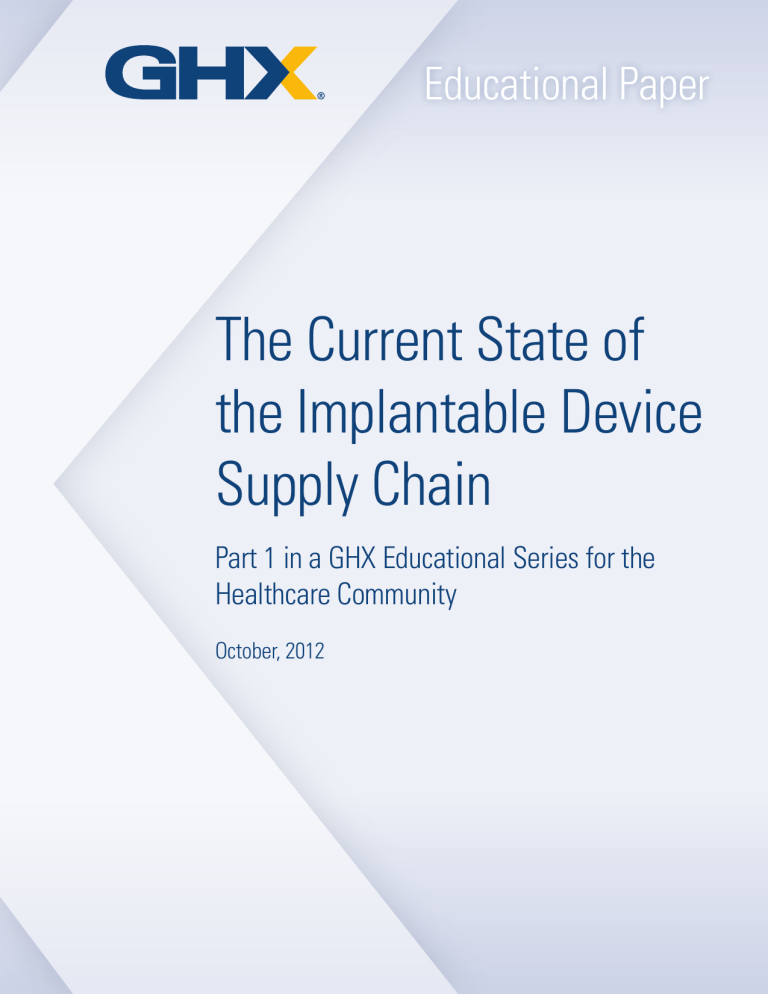
Educational Paper The Current State of the Implantable Device Supply Chain Part 1 in a GHX Educational Series for the Healthcare Community October, 2012 The Current State of the Implantable Device Supply Chain “The Current State of the Implantable Device Supply Chain” is the first in a series of educational papers about issues related to implantable device management, including key findings from the GHX Provider and Manufacturer Advisory Boards and their associated work groups. This initial paper provides an overview of today’s implantable device supply chain (IDSC). Future papers will focus on specific work group findings and provide best practice recommendations to help achieve the perfect physician preference item (PPI) order and real-time contract synchronization for implantable devices. GHX is presenting information and findings to the broader healthcare community in an effort to help providers, suppliers and their business partners understand the process and technology changes required to tackle this industry-wide challenge. The Current State of the Implantable Device Supply Chain Part 1 in a GHX Educational Series for the Healthcare Community Introduction The effective management of implantable medical devices (e.g., hips, knees and cardiac stents), including PPI, is an industry-wide issue that affects healthcare efficiency and profitability for both healthcare providers and suppliers. While implants represent approximately $40 billion as a market segment,1 lack of visibility and control over these devices costs the healthcare industry an estimated $5 billion per year from inefficient, disconnected manual processes, and lost, expired and wasted product.2 Due to its inherent complexity, the IDSC has resisted automation and the adoption of e-commerce approaches. From the point of manufacture to the point of use, through reconciliation and billing, implantable device pathways are nonstandardized, non-uniform and involve dozens of stakeholders. Insiders have long recognized the value an IDSC solution could deliver, but the hurdles impeding its realization have been prohibitively high. To address what providers and suppliers say is one of their biggest challenges— the highly manual, disjointed and duplicative processes surrounding the use of implantable devices in the operating room (OR) and catheterization laboratory (cath lab)—GHX has formed advisory boards and work groups comprising representatives from some of the leading healthcare systems and medical device manufacturers. Working together with GHX, these individuals have identified best practices that the industry can employ to help take costs out of the IDSC without negatively impacting patient care or safety. The Current State of Implantable Device Management As a highly manual process, implantable device management is marked by significant lost revenue from incorrect patient charges, disputed charges, and lost or expired inventory; lack of analytics for value analysis teams; and lack of adherence to barcode standards. Current products for implantable devices don’t address the entire supply chain, and are most often point products that address a singular need. For suppliers, this means they lack a complete solution that helps them overcome challenges that include: inventory management; lack of advance schedule notice; rush shipping of products; lack of real-time inventory; and limited PO visibility. Implantable devices are expensive, difficult to track and can account for up to 80 percent of the total cost of a procedure. They are often delivered by a supplier sales rep or stored within a hospital and processed as consigned, bill-only orders once used. Procurement of these items usually occurs outside the hospital’s materials management department, taking away from precious clinician time. 2 The Current State of the Implantable Device Supply Chain Overall, suppliers and providers lack visibility into what’s being used and sold, and implantable device management offers huge opportunities for process improvement and cost reduction. The medical-surgical supply chain versus the IDSC In the medical-surgical consumables market, the supply chain is based on procure-to-pay, e-commerce solutions. Products are requisitioned within a hospital or Integrated Delivery Network (IDN) and managed by the materials management department. Essentially, a product is ordered per the contract, shipped by the supplier, received by the hospital, entered into inventory and then used. The IDSC is very different: it’s based on a pay-to-replenish cycle and is made up of largely manual processes. Product is consigned by the supplier to the hospital or pulled from GHX IDSC Activities GHX is working with provider and manufacturer organizations to develop the industry’s first supply chain solution to better manage implantable devices. Current activities include: • Advisory Boards: Comprising representatives from some of the leading healthcare systems and medical device manufacturers, the GHX Provider and Manufacturer Advisory Boards are working to assess the IDSC and discover new ways to better manage implantable devices. Quarterly, the advisory boards identify an element of the IDSC to address (e.g., defining a perfect PPI order, contract data synchronization), and then assign subject matter experts from within their organizations to participate in work groups. • Work Groups: Work groups comprise subject matter experts who are tasked with examining specific IDSC issues and developing best practice recommendations for enacting meaningful and sustainable change. • Special Interest Groups: To reach a broader audience, GHX conducts quarterly meetings that bring together peers from organizations beyond our advisory boards. Participants can join discussions to learn more about what they can begin doing today to better manage implantable devices in their organizations. • Pilots: GHX is in the first phase of pilots with GHX Provider and Manufacturer Advisory Board members to develop an industry-wide IDSC solution. For more information about these activities, please contact Marco de Vries, GHX Executive Director of Strategic Business Development, at mdevries@ghx.com. the car of a supplier sales rep and walked into the hospital; product demand is driven by consumption; and the product may or may not be on a contract. The paperwork is largely manual, with sales reps and OR nurses responsible for its reconciliation. Frequent, ongoing errors are consistently reported within this process. To illustrate the challenges faced by hospitals, following is a typical implant procedure scenario: • In the OR, the circulating nurse hands the implant to the sterile technician. • The circulating nurse and the supplier sales rep use stickers from the implant packaging to log usage on paper records. • Because many implants are used on consignment by the hospital, the circulating nurse and the sales rep keep separate logs of what was used in the OR. • When the implant packaging does not have labels, clinicians must hand-write on the implant log or manually enter information into a computer. • Often nurses save an implant label by sticking it to their uniform until they have time to return to the workstation and complete paperwork. • Implant stickers are often left stuck to the work surface of the nurse’s workstation when demands in the OR require attention. When nurses return, they pick up where they left off. Implantable Devices and Suppliers Implantable devices account for approximately $40 billion per year in revenue for healthcare manufacturers. However, lost revenue and lack of meaningful use data impacts their ability to meet the needs of customers, which include more than 5,000 acute care hospitals and 5,260 surgical centers in the U.S. alone. As reimbursements shrink for hospitals and other healthcare providers, suppliers are challenged with keeping prices competitive while retaining their own corporate health. In addition, product performance requirements for the introduction of new implantable devices are becoming more like those for pharmaceuticals, with legislation that will require manufacturers to invest in more research and trial data before bringing a product to market. With customers that are expensive to serve, suppliers face SG&A (Selling, General and Administrative) costs that average 2x higher than other industries. They need to find ways to grow market share and increase revenue so they can continue to fund the research and development efforts and new business initiatives that enable them to sustain profitable business operations. Implantable devices account for a significant opportunity, or liability. 3 The Current State of the Implantable Device Supply Chain Based on GHX research, manufacturers are currently managing many types of inventory: • Owned and stocked in hospitals (40 percent) • Consigned and stocked in hospitals (25 percent) • Trunk/bill-only stock held by sales reps (28 percent) • Other field inventory, excluding distributor (14 percent) The way the industry currently manages implantable devices results in a lack of visibility into product inventory and usage, and makes it difficult to automate data capture. This means suppliers don’t have data on implanted products, which is problematic in the event of a recall, nor do they have access to product outcome information. Supplier sales reps are tasked with managing paper and tracking product, and ultimately they have too much product in the pipeline. The most common implantable device dispute is pricing discrepancies on the invoice. The net/net of this situation is that without visibility of and accurate accounting for inventory, products are being lost, improperly billed and frequently expire before they can be used, with little documentation of product-to-patient information in the event of a recall. Product usage is most often reconciled by the sales rep and the clinical staff. A current trend is for each supplier to provide a different tool to streamline the implantable device process. In this scenario, a nursing team is using multiple vendor tools for implantable device tracking and reconciliation, which requires more training and lowers efficiency. Improving the IDSC by moving to electronic business processes could reduce operational expenses, helping to lower product order costs. In addition, such a supply chain would help reduce lost, wasted and expired product that cost suppliers more than 6 percent of annual sales revenues,3 and speed invoice reconciliation for lower days sales outstanding (DSO). Post-procedure reconciliation of products is needed since supplier sales reps often spend time on materials management type work. Suppliers are asking for near real-time reconciliation of implantable device and PPI usage for accurate PO/invoice processing that includes: • A web-based solution that tracks implantable products brought into the procedure suite and used during a case. The solution should support scanner (barcode or RFID) and keyboard entry. It should also include secure access to product data including description, part number, lot number, serial number and contract price. • Real-time data access for both the supplier and hospital, enhanced inventory management for both, automation and real-time information, and efficient data capture. The solution needs to dramatically reduce opportunities for human error. • Ability to add items and have a final reconciliation at the end of the procedure with the automatic request for replenishment of used materials. For suppliers, the goal of an industry solution is: • Increase in supplier sales rep efficiency • Reduction in expedited deliveries • Reduction in product usage reconciliation • Increase in invoice/payment cycle time from date of procedure • Reduction in expired product • Reduction in invoice disputes • Increase in inventory returns • Reduction in out-of-stocks For hospitals, supply spend is the second largest operating expense and growing faster than any other area of spend. Additionally, suppliers would benefit from better partnerships with customers by working with them to improve shared business processes and reduce operational costs. An ideal solution would provide them with direct information on patient implant information for U.S. Food and Drug Administration (FDA) Unique Device Identification (UDI) requirements, a direct link to their enterprise resource planning (ERP) systems, and better tracking and reporting for data analysis. Implantable Devices and Providers Hospitals lose money due to lost or wasted product, which is especially challenging in the face of declining reimbursements. As economic burdens continue and the healthcare environment evolves, the pressure to reduce costs while delivering highquality services and products for patient care is soaring. Now, more than ever, healthcare organizations need to create more sustainable, profitable business models. For hospitals, supply spend is the second largest operating expense and growing faster than any other area of spend. There is an urgent need to identify and implement new ways to lower this spend—today and in the future. Additionally, hospitals must be able to maximize their reimbursements, so they can drive the revenue needed to sustain their operations. The IDSC provides opportunities for more accurate patient billing and reductions in hospital-based inventory, losses due to expired/wasted product and expedited deliveries. Hospitals want to be able to work with their vendors to collect data about implantable device usage at the point of care. Only then can 4 The Current State of the Implantable Device Supply Chain they reduce errors, improve accurate charge capture and gather the intelligence they need to understand utilization and the role implantable devices play in delivering value to patients. Although 88 percent of hospitals have electronic scheduling, only 15 percent transmit for manufacturer representative notification; telephone calls are the most frequently used method for bill-only products. More than 75 percent of hospitals pick 75 to 100 percent of their products for a procedure based on physician preference cards, which are frequently outdated due to the difficulty in maintaining this information. Then, up to 80 percent of stock is returned to its stock location, but may not be reconciled with the system.4 Even though most hospitals have charting systems, handwritten, bill-only records of items consumed in a procedure are still a critical part of the process. The clinical staff is most often responsible for document generation for invoicing, and there is no standard for the official record of usage for accounts payable (AP) reconciliation. And while many hospitals have electronic charting, only 38 percent report that a record of these implantable devices is electronically generating patient charges. Not surprisingly, hospitals report that upwards of 46 percent of patient charge Suppliers envision a global solution that will help them better understand product logistics records are inaccurate. For providers, an IDSC to manage solution that captures product data at the point inventory flow of use would help them total costs per and reduce illegal determine procedure, increase billing accuracy and improve diversion inventory management. 5 In addition, connecting with suppliers and automating management of implantable devices would help: • Increase the accuracy of patient billing • Reduce hospital-based inventory • Reduce losses due to expired products • Reduce losses due to wasted product • Reduce expedited deliveries By sharing demand data with suppliers, providers can collaborate with trading partners to help reduce the costs associated with expired, excess and obsolete inventory. Providers want to capture every dollar earned for surgical services. An ideal IDSC solution would automate and control implanted product order processing, while capturing product spend. Providers need to eliminate duplicate and redundant work while validating that the charged amount is what was negotiated. Any solution must provide documentation that supports charge capture activities, and let clinicians be clinicians, not materials managers. A Solution for Suppliers and Providers One of the most important requirements and the biggest challenge in creating an IDSC solution is that it must span suppliers and providers. Suppliers need to be able to continuously and electronically provide the up-to-date part numbers, pricing and charge codes needed for providers to bill and order in an accurate and timely fashion. And providers need to be able to electronically send data back to suppliers in real time to help them reduce the costs associated with managing the complex IDSC. The benefits on both sides through this model would help the industry reduce costs while maintaining the product quality needed for patient care. Suppliers envision a global solution that will help them better understand product logistics to manage inventory flow, and also to address the need for clinical data regarding product performance. Both suppliers and providers require a standards-based infrastructure, one that uses accepted global data standards coupled with an industry-wide standards implementation effort (including label technology and solution component interoperability). Manufacturers need to prove efficacy relative to other devices and modalities throughout the life of a product, but also require a solid data privacy policy that will control access to outcomes data. To benefit both suppliers and providers, an IDSC solution should enable: • Management of multiple data sources • Single catalog repository to normalize data feeds and sources • Accurate / intuitive capture at point of use of implants and devices • Automated, touchless electronic transactions for consignment orders • System integration on both sides of the supply chain that supports workflow requirements for consigned implants and devices • Transparent pricing visibility and agreement and support for complex pricing • Visibility and tracking of field consigned inventory 5 The Current State of the Implantable Device Supply Chain Conclusion At a time when healthcare organizations are rigorously working toward providing the best products and enabling the highest quality patient care, addressing inefficiency in implantable device management is a clear opportunity. An ideal IDSC solution would meet the needs of suppliers and providers, delivering dramatic process and business improvements that could help capture up to $5 billion in available savings. The potential gain for both sides in this model would help the industry reduce costs while maintaining the product quality needed for patient care. The current and desired future state of implantable device management based on input from the GHX Provider and Manufacturer Advisory Boards Current Future Manual capture by sales rep. Manual notification of sales rep. Automatic capture via clinical integration. Automated notification to sales rep. Case Prep Manual prep by sales rep. Manual validation between sales rep and clinician. Streamlined prep by sales rep. Automated validation between sales rep and clinician. POU Capture Manual or automatic capture by sales rep (no reconciliation) Automatic capture by sales rep / real-time reconciliation with clinician Sales Order Manual creation by sales rep Automatically generated from POU capture (same day) PO Approval Manual generation from paper implant record by materials manager. Manual approval by auditor. Manual follow-up by sales rep. Sent by mail/fax. Automatically generated from POU capture (same day). Streamlined approval by auditor. Automated follow-up by system or sales rep. Sent electronically. Invoice Automatic generation but failed PO-match commonplace Automatic generation with high match rates Inventory Visibility Automatic capture (with scanner) by sales rep Automatic capture (with scanner or cabinet) by sales rep or hospital Managed Inventory Limited. Dock to door only. Single-supplier solutions. More complete. Dock to usage/implant. Multisupplier solution. Case Schedule & Notification & Submission 1 Millennium Research Group, 2011 Estimated North American Healthcare Product Expenditures, 2011 2 PNC Healthcare, GHX Quantitative Research Study, August 2011 3 PNC Healthcare, GHX Quantitative Research Study, August 2011 4 GHX PPI Quantitative Study Hospital Results, October 2010 5 GHX PPI Quantitative Study Hospital Results, October 2010 www.ghx.com 1315 W. Century Drive Louisville, CO 80027 USA 1.800.YOUR.GHX ©2012 Global Healthcare Exchange, LLC. All rights reserved. GHX is a trademark of Global Healthcare Exchange, LLC. 6
